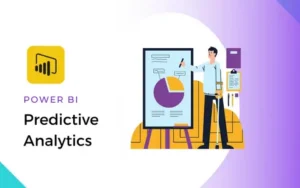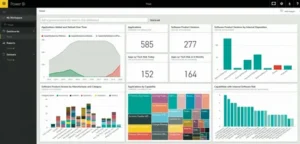Introduction
In today fast moving business environment, simply understanding what happened is no longer enough. To get ahead, organizations need to anticipate what will happen. That is where predictive analytics in Power BI comes in, transforming your dashboards from descriptive to forward looking and enabling proactive decision making.
This article explains how Power BI supports predictive analytics, outlines the steps for implementation, highlights use cases, and shares best practices to maximize value.
What Is Predictive Analytics in Power BI
Predictive analytics refers to the use of statistical algorithms and machine learning techniques to analyze historical data and forecast future outcomes. It goes beyond reporting on past and present performance to estimate probabilities of events, identify trends, and help plan for tomorrow.
In Power BI, predictive analytics can be achieved through multiple pathways such as built in forecasting visuals, custom DAX calculations, integration of R or Python scripts, and embedding models from platforms such as Azure Machine Learning.
How Power BI Enables Predictive Analytics
Data preparation and modeling
High quality data is the foundation. Power BI allows you to connect to various data sources, cleanse and transform data using Power Query, and create models that reflect business logic.
Using DAX for simple forecasting
For lower complexity scenarios, you can use DAX to calculate trends or predict next actions. For example, one might compute the average time between events and estimate when the next event will occur.
Applying machine learning and scripting
For more advanced predictive needs, Power BI supports embedding R or Python scripts. You can train a model externally or within Power BI, generate predictions, and visualize the results within the same report.
Deploying integrated predictive models
Power BI also supports integration with Azure Machine Learning and related services to bring enterprise grade models into your reports. This blend of business intelligence and machine learning helps bring advanced predictions into everyday dashboards.
Key Use Cases
- Sales forecasting
- Customer behavior modeling
- Maintenance and resource planning
- Risk scoring and fraud detection
These use cases enable businesses to move from reactive actions to proactive strategies.
Best Practices for Adoption
- Define a clear business goal
- Ensure data quality and completeness
- Choose the right predictive method
- Communicate predictions clearly
- Monitor and retrain models regularly
- Understand licensing needs and capacity limits
Challenges to Consider
- Interpretability of complex models
- Performance constraints for large datasets
- Risk of misinterpretation if models are not governed
- Prediction accuracy depends on data quality and structure
What is predictive analytics in Power BI?
It is the process of using historical data and algorithms in Power BI to forecast future outcomes and trends.
Can Power BI perform machine learning tasks?
Yes, Power BI allows integration with Python, R, and Azure Machine Learning for advanced predictive modeling.
Is DAX enough for predictive analytics?
DAX can handle basic trend analysis but complex predictions may require scripting or external tools.
What industries benefit from predictive analytics in Power BI?
Industries such as retail, finance, logistics, and healthcare use it to optimize operations and forecast demand.
Does Power BI support time series forecasting?
Yes, Power BI offers built in visuals for forecasting based on time series data.
What tools integrate with Power BI for predictions?
Python, R, Azure Machine Learning, and SQL based models can be embedded into Power BI dashboards.
Do you need coding skills to use predictive features in Power BI?
Basic forecasting can be done without code, but advanced analytics requires knowledge of Python or R.
Can Power BI visualize prediction results?
Yes, it displays predictions through interactive visuals, charts, and custom dashboards.
How accurate is predictive analytics in Power BI?
Accuracy depends on data quality, model type, and proper configuration of parameters.
What are common use cases for predictive analytics in Power BI?
Common applications include sales forecasting, churn prediction, demand planning, and resource optimization.
Final Thought
Predictive analytics within Power BI allows organizations to shift from looking backward to planning forward. Whether you are optimizing sales, managing risk, or improving operations, integrating predictive methods into Power BI provides a smart, scalable way to enhance decision making.

